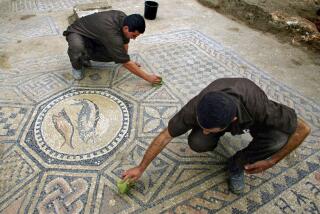Ethiopia Wants Its Pillaged Pillar
- Share via
ROME — What Ethiopian Ambassador Mengistu Hulluka can’t figure out is why influential Italians even want the 80-foot carved granite pillar that stands, without any identification, at a smoggy Rome intersection.
For Ethiopians, he said, the ancient Axum Obelisk, looted from his country by dictator Benito Mussolini’s forces in the prelude to World War II, is a stolen symbol of national identity. But what is it for Italians?
“Is it a symbol of fascism?” he asked. “Is that what they are after? That’s what it reflects, really, if it remains in Rome.”
It might seem that the obelisk won’t be here much longer, because the Italian government has agreed to give it back. But it’s already agreed three times, in 1947, 1956 and 1997, and somehow the obelisk still stands near Italy’s former office for African colonies.
The long dispute is part of a broader global battle over whether art objects that were stolen decades or centuries ago, often by colonial powers, should be returned to their countries of origin.
This particular fight has escalated sharply in recent weeks.
First, a lightning strike damaged the obelisk, breaking off about six feet of granite in large chunks and provoking Ethiopian anger that it hadn’t been better protected.
Then, at a world hunger summit in Rome, Ethiopian Prime Minister Meles Zenawi blasted Italy for giving his country “the runaround” for 55 years “as one excuse after another is created to frustrate the implementation of these agreements.”
“In the meantime, the obelisk is subjected to the heavy traffic and pollution of Rome, and provided no protection against the elements,” Meles said. “As a result, the obelisk has begun to crumble
The summit was held in the headquarters of the U.N. Food and Agriculture Organization--which just happens to occupy the old colonial office, with the obelisk right outside.
The Italian government still maintains that it is going to give the obelisk back, Mengistu said. But now it has decided--over Ethiopia’s strenuous objections--that the damage from the lightning strike should be repaired first. Workers have already fenced in the obelisk in preparation for that project.
“Any restoration work that needs to be done should be done after the obelisk is dismantled and taken back to its original place,” Mengistu said. “We’re a bit suspicious, really, [that] once it is restored, they may keep it.”
Over the past decade, arguments against returning the obelisk have focused on claims that it is safer in Rome than it would be in Axum, that it might be damaged by a move and that it has been here so long that it has become part of Italy’s heritage.
Those first two arguments were weakened, if not demolished, by the May thunderbolt, and it is mainly right-wing nationalists who are bold enough to claim that 65 years in Italy outweigh two millenniums in Axum.
Frequent changes of government in Italy and political upheaval, wars or famine in Ethiopia played a role in the failure to implement all three agreements.
The obelisk, which has door and window designs on its sides, is estimated to be about 2,000 years old and to weigh about 180 tons. Mussolini ordered it taken in 1937 from the holy city of Axum, the cradle of Ethiopia’s civilization and a key site in the development of Christianity in that country.
The pillar was set up at its current site that same year both to mark Italian power in Africa and to commemorate the 15th anniversary of the fascist “March on Rome” that put Mussolini into power.
Mussolini’s display of the Axum Obelisk was also meant to echo the deeds of Roman emperors who brought back monuments from ancient Egypt, some of which can still be seen in Rome today.
While numerous other obelisks still remain in Axum, the one in Rome is one of the biggest and most elaborately carved.
“The Italians really value very much their monuments, their ruins,” Mengistu said. “Consider how many tourists they are attracting because of their ruins. We want to value the glories of the past. This is really what we are after. [The obelisk] reflects the past glory, and we want to show it to the international community in its original place.”
Italy first agreed as part of a 1947 peace treaty to return the obelisk and all other artistic, religious and historic objects taken from Ethiopia after Italy’s 1935 invasion. It returned some items but not the obelisk. A second agreement was reached in 1956. Disputes over shipping costs played a role in the breakdown of that deal.
The 1997 agreement had promised to return the obelisk by year’s end. After that deadline passed, some Italian officials cited the 1998-2000 border war between Ethiopia and Eritrea as a reason for further delay.
Ethiopia believes Italy used the fighting as an excuse, Mengistu said. “My government believes it’s not really out of concern for the monument. We suspect it is a matter of keeping it longer here. That is why the people are angry.”
Rarely spoken of is what could be the critical explanation for Italy’s behavior: fear that giving the obelisk back would open the door to demands by other countries.
In 1996, Rino Serri, who was then undersecretary of foreign affairs and a vocal supporter of quickly returning the obelisk, alluded to this concern.
“I believe that perhaps certain circles in Italy and abroad are afraid that a precedent will be set,” Serri said.
Ironically, the lightning strike converted one of the fiercest opponents of returning the obelisk, former Culture Undersecretary Vittorio Sgarbi, into one of the most high-profile proponents of giving it back.
Sgarbi said his opposition had been based mainly on the view that this important cultural treasure faced the risk of damage if sent back. It was brought to Italy in several pieces, and returning it would require disassembling it and putting it back together again, with what he believed would be serious risk of harm, he said. He no longer sees that as an issue.
“Now because it’s broken, we can give it back to them,” he said.
Meanwhile, the Ethiopian Parliament responded to Italy’s continued foot-dragging with an angrily worded resolution approved June 18 by an almost unanimous vote. “Failure to return the obelisk without delay will be detrimental to bilateral relations between the two countries,” it declared.
For Ethiopia to threaten Italy with a worsening of relations may not seem like the most frightening thing in the world.
But Mengistu said Rome genuinely wants to have influence in Ethiopia and neighboring countries of the Horn of Africa, where Italy traditionally has had significant business, cultural and diplomatic ties. “Italy has a stake in Africa,” Mengistu said.
It is not just political leaders but ordinary Ethiopians who care deeply about the obelisk issue, Mengistu added. “The whole country is out to get this monument back,” he said. “They consider it as their own identity.”
Holley was recently on assignment in Rome.
More to Read
Sign up for Essential California
The most important California stories and recommendations in your inbox every morning.
You may occasionally receive promotional content from the Los Angeles Times.










